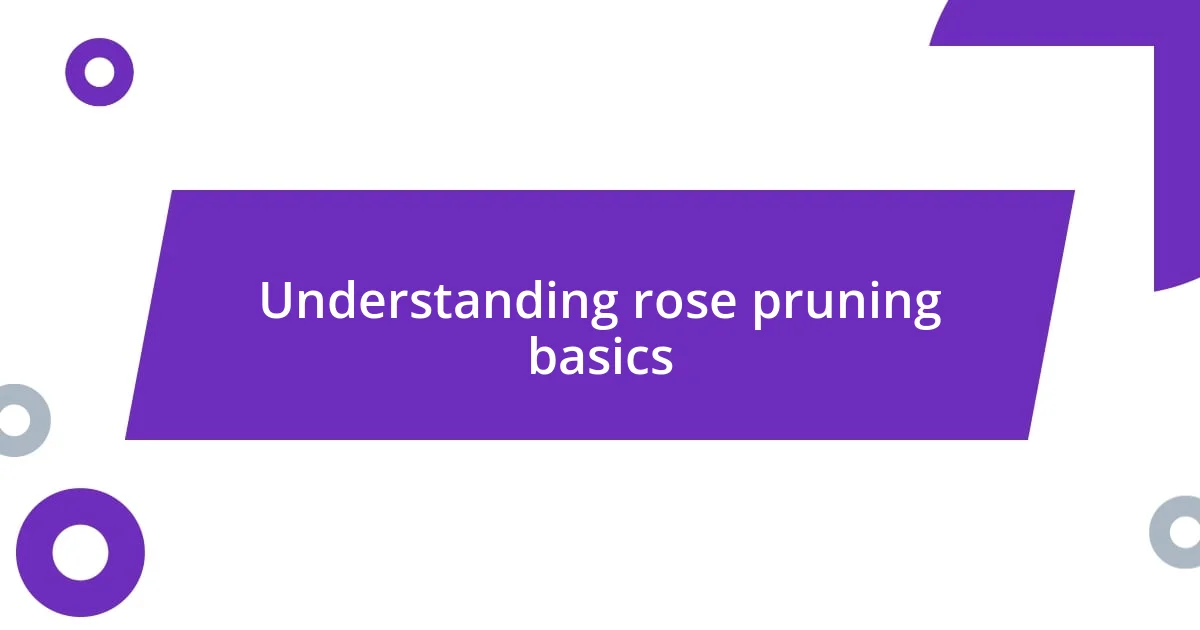Key takeaways:
- Pruning roses is best done in early spring after the last frost, focusing on dead or diseased wood to encourage healthy growth.
- Utilize proper tools like pruning shears and loppers, and make clean, angled cuts to prevent disease and promote vitality.
- Post-pruning care, including watering, fertilizing, and monitoring for stress or disease, is crucial for successful recovery and blooming.

Understanding rose pruning basics
When it comes to pruning roses, understanding the plant’s growth patterns is crucial. I remember the first time I pruned my own roses; I felt a mix of excitement and anxiety, worrying I might harm them. Have you ever hesitated to cut back something you thought was thriving? It’s a common feeling, but knowing how to anticipate their growth cycle can ease that fear.
Pruning is not just about snipping away branches; it’s about encouraging healthy growth and beautiful blooms. I’ve found that cutting during the right season, ideally in early spring, sets the stage for a flourishing garden. It’s fascinating how a little attention can lead to a vibrant explosion of color in your yard. Have you experienced that transformation?
The basic principles of rose pruning involve removing dead or diseased wood while shaping the plant for better airflow. I often feel a sense of satisfaction when I notice the results—those carefully pruned roses rise up with strength as if they’re thanking me for the care. Understanding these basics allows you to engage with your garden in a more rewarding way, don’t you agree?

Best time to prune roses
When it comes to pruning roses, timing truly is everything. I’ve always found that the ideal moment is in early spring, just as the buds begin to swell and there’s a hint of warmer weather. There’s something exhilarating about holding my pruning shears while anticipating that first burst of life as the roses respond to my careful cuts. It’s like a dance—knowing the right time to step in makes all the difference in their vibrant performance.
Here are some things to keep in mind regarding the best timing for pruning roses:
- Early Spring: Look for signs of new growth, typically when temperatures start to rise.
- Post-Frost: Ensure you wait until after the last frost date in your area; a sudden cold snap can damage fresh cuts.
- Growth Stages: If your roses are actively showing signs of budding, it’s the perfect time to prune; they’ll thrive afterward.
- Type of Rose: Different varieties may require varied timing; for instance, hybrid teas usually do well with spring pruning.
Timing and technique are like the secret ingredients to a successful gardening experience. I’ve seen the plants flourish wonderfully because of it!

Necessary tools for pruning
Pruning roses effectively requires a few key tools, each playing an important role in the process. I can’t stress enough how much I rely on my trusty pruning shears. They are my best friend in the garden, allowing precise cuts that promote healthy regrowth. When I first started, I used basic scissors, which was a disaster—who knew that the right tool could make such a difference?
In addition to shears, I’ve found a good pair of loppers is essential, especially for thicker branches that need a bit more muscle. I remember a particularly stubborn rose bush that resisted my efforts until I switched to loppers. The satisfaction I felt when the branches finally gave way was incredible: it was like wrestling a wild beast and emerging victorious! It’s in these moments that having the right tools changes the game.
Finally, don’t overlook gloves and protective eyewear. While they might seem like an afterthought, I’ve had my share of thorns and splinters that reminded me the hard way to be cautious. Investing in good gear keeps the experience enjoyable and lets you focus on the beauty you’re cultivating. Each tool has its place in the magical transformation of your rose garden.
| Tool | Purpose |
|---|---|
| Pruning Shears | For precise cuts on smaller branches |
| Loppers | For cutting thicker branches |
| Gloves | Protection from thorns |
| Protective Eyewear | To shield eyes from debris |

Techniques for effective pruning
When it comes to techniques for effective pruning, my first piece of advice is to always make clean cuts. I’ve learned the hard way that jagged edges can lead to disease or even death in roses. Imagine accidentally slicing a branch with dull scissors; it’s frustrating. Using sharp, clean pruning shears not only feels better but is crucial for the rose’s recovery. It’s almost a therapeutic process, knowing I’m setting my plants up for success right from the get-go.
Another technique I’ve embraced is the “cutting at a slant” method. I once tried cutting straight across and was baffled when my roses struggled to thrive. By angling my cuts at about a 45-degree angle, I encourage better water runoff and minimize the chance of rot. Plus, it just looks nicer when I step back to admire my work! This small shift in technique made a significant difference, and I genuinely felt the plants respond quickly, almost as if they were thanking me.
Lastly, I can’t stress enough the importance of removing dead or damaged wood. Initially, I was hesitant to cut back branches that seemed fine but were clearly no longer contributing to the bush’s vitality. One day, I discovered an entire branch that was stubbornly holding onto wilted leaves; it shocked me to see how much better the whole plant looked after I made that cut. It’s a bit like decluttering your living space—everything breathes easier when the unnecessary is removed. Have you ever experienced that refreshing feeling? It’s the same for roses; they thrive with a little room to grow!

Aftercare following pruning
After pruning, the aftercare is just as critical to your roses’ health as the actual pruning itself. I always make it a point to give my roses a good drink of water immediately after I’ve finished cutting. There’s something satisfying about watching the roots absorb the moisture, enabling them to start healing right away. Have you ever noticed how plants perk up after a drink? They seem to respond with gratitude!
One of my go-to practices involves applying a nutrient-rich fertilizer post-pruning. It’s amazing how a little boost can help the plants recover faster and grow stronger. I remember one year, I skimped on this step, and my roses took ages to bounce back. Learning from that experience, I now make it a ritual to fertilize; it feels like giving them a much-deserved treat. Plus, the vibrant blooms that follow are a reward in themselves!
Lastly, I keep a close eye on my roses for any signs of stress or disease after pruning. It’s like being a protective parent—after the initial cut, I monitor their progress and address any issues that arise promptly. For instance, I once noticed some leaves turning yellow, which indicated a nutrient deficiency. Addressing it right away ensured that my roses continued to flourish. How often do we overlook the little signs that signal our plants need a bit more love? By staying vigilant, I can provide the necessary support and watch my garden thrive!

Common pruning mistakes to avoid
I’ve certainly had my share of slip-ups when it comes to pruning roses, and one common mistake was assuming all cuts were created equal. At one point, I didn’t pay attention to where I made the cut; I only focused on the angle. It wasn’t until I realized that cutting too close to a bud could damage it that I changed my approach. Leaving a little extra length just above the bud has made such a difference—like giving the plant a fighting chance to flourish.
Another error I learned from was improper timing. In my eagerness to see blooms, I often jumped into pruning too early in the season. I remember an instance where I got a little too excited and pruned in late winter, only to find my roses were slower to bloom than I hoped. Now, I’ve made it a point to observe the weather and prune only when the threat of frost has passed. It’s like waiting for the right moment in life—timing affects everything!
One thing that stands out in my experience is neglecting to clean my tools between different plants. I chuckle at how I thought it wouldn’t matter—until a few branches got an unexpected dose of something nasty. Suddenly, I was facing the risk of disease spreading through my garden. Now, I fantasize about a spotless pair of shears, cleaning them between each cut. It’s like creating a safe environment for my roses, ensuring they have the best chance to thrive! Wouldn’t we all prefer a clean start?














